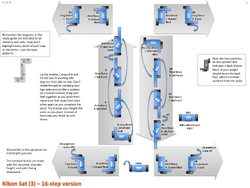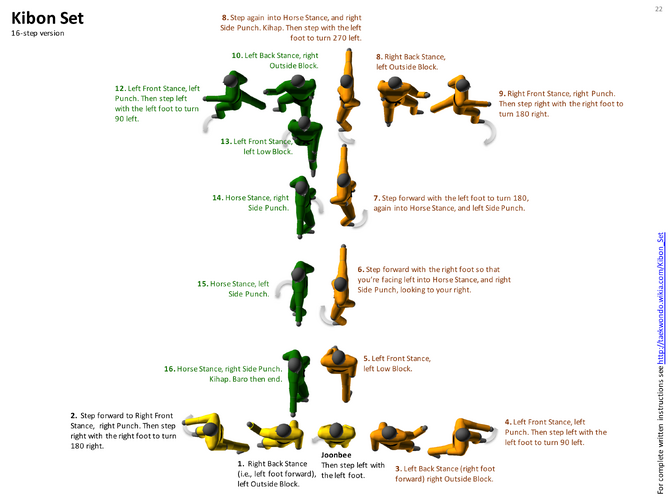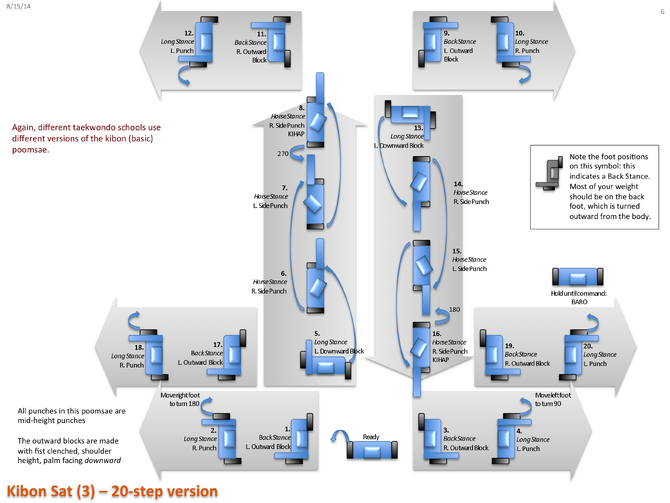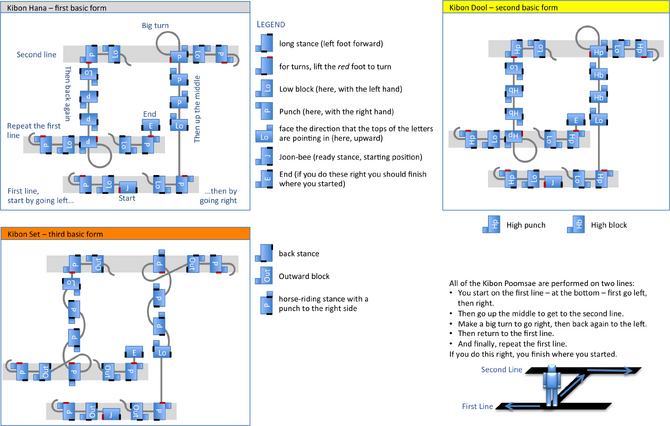
8gup Orange Belt Kibon Set
The term Kibon Set means "basic #3" - set (or sat) is the number 3 in the traditional Korean numbering system. Kibon Set is a simple, basic form (poomsae) often taught to introductory students at some taekwonwo schools after Kibon Dool, especially in Kukkiwon/WTF-style taekwondo. Unlike the standard Kukkiwon/WTF-forms, the Kibon forms are not standardized: different schools use different forms. Often, the forms are based on the Tang Soo Do forms Kicho Hyeong Il Bu, Ee Bu, and Sam Bu. After Kibon Set, most Kukkiwon/WTF-style schools would then teach the form Taegeuk Il Jang, the first of the Kukkiwon "standardized" forms.
The following diagram shows a top-down view of a typical 16-step version of Kibon Set taught at some schools. Your school's form may be different.
- All of the stances in this version of the form are Front Stances (aka Long Stances), Back Stances, and Horse-Riding Stances.
- All of the blocks are Low Blocks (aka Downward Blocks) and Outside Blocks (aka Outward Blocks).
- All of the punches are middle-height punches.
The "lines" of the form are an I-shape. You start by moving to the left, then back to the right. Then up the middle. Then to the right, and back to the left. Then back down the middle.
20-Step Version[]
The following diagram is a 20-step version of Kibon Set where the first line is repeated at the end, adding an extra 4 steps to the form.
Written Instructions[]

A couple things to keep in mind when reading about this form:
- If the instructions say do a Right Back Stance, that means the right-foot should be back. The Back Stance is different than most stances, because most stances are named by which foot is forward (left or right). The Back Stance, however, is named by which foot is back.
- The Outside Blocks (also called Outward Blocks) are performed by using the outer forearm (the pinky-side of the forearm) to block with. That means that the blocks are done palm-down.
Start in the "Joonbee" Ready Stance.
The First Line[]
First Going Left (Da 1)...
- Chamber the left fist to the right hip. Chamber your right fist to your left shoulder.
- 1. Step left with the left foot to turn left 90 degrees into a Right Back Stance (i.e., the left foot will be forwad and the right foot will be back). At the same time, Outside Block (aka Outward Block, palm of the fist facing downward, so that you're blocking wth the outer forearm) with the left arm, while pulling the right fist back to your right hip (palm-up).
- Then aim for the upcoming punch by raising the left fist straight out in front of you.
- 2. Step forward with the right foot into a Right Front Stance. Simultaneously middle-height Punch with the right fist; of course, at the same time pull your left fist back to your left hip (palm-up, of course).
Then Going Right (mirror image, Ra 1 direction)...
- Chamber for the block by bringing the right fist to your left hip.
- 3. Step back and to the left with your right foot so that it's way behind you and to the left, then pivot on the left foot 180 degrees to the right so that now you're in Left Back Stance (i.e., right foot forward). Simultaneously Outside Block with your right arm.
- Aim for the upcoming punch by raising the right fist straight out in front of you.
- 4. Step forward with the left foot into a Left Front Stance. Left Punch.
- Chamber the left fist to the right shoulder.
Transition to the Second Line[]
- 5. Step left with the left foot to turn 90 degrees left into a Left Front Stance. Left Low Block.
- At the conclusion of your Low Block, your right fist should of course be at your right hip, palm up. Chamber for the upcoming clock by moving your right fist to the left hip. In other words, your right fist just travels left along your belt. Chamber the left fist to the right shoulder.
- 6. Step forward with the right foot to turn another 90 degrees left into a Horse-Riding Stance facing in the Da direction. Right Side Punch; in other words, look to your right side and punch to your right side.
- 7. Step forward with the left foot to pivot 180 degrees right into a Horse-Riding Stance facing in the Ra direction. Left Side Punch.
- As you pivot 180 degrees, try not to swing your legs wide around "like a cowboy." Instead, try to make the pivots smooth by bringing the feet near each other and then spreading them apart again as you pivot. What makes this hard is that you might be tempted to bob up-and-down as you pivot; you want to avoid that -- try to keep your head at the same height throughout the movement. That means you'll need to use some leg muscles to keep your pivoting knee bent during the pivot.
- 8. Step forward with the right foot to pivot 180 degrees left into a Horse-Riding Stance facing in the Da direction. Right Side Punch. Kihap (yell).
The Second Line[]
First Going Right (Ra 2)...
- 9. With the left foot, step back and to the right. Then pivot left on the right foot so that you wind up turning left 180 degrees into a Right Back Stance. Left Outside Block.
- Aim the left fist straight out in front of you.
- 10. Step forward with the right foot into a Right Front Stance. Right High Punch.
- Chamber the right fist to the left hip.
Then Going Left (mirror image, Da 2 direction)...
- 11. Step back and to the left with the right foot, then pivot 180 degrees to the right on the left foot into a Left Back Stance. Right Outside Block.
- Aim the right fist straight out in front of you.
- 12. Step forward with the left foot into a Left Front Stance. Left High Punch.
Transition Back to the First Line[]
- 13. Step left with the left foot to turn 90 degrees left into a Left Front Stance. Left Low Block.
- Chamber the right fist to the left hip.
- 14. Step forward with the right foot to turn another 90 degrees left into a Horse-Riding Stance facing in the Da direction. Right Side Punch.
- 15. Step forward with the left foot to pivot 180 degrees right into a Horse-Riding Stance facing in the Radirection. Left Side Punch.
- As you pivot 180 degrees, try not to swing your legs wide around "like a cowboy." Instead, try to make the pivots smooth by bringing the feet near each other and then spreading them apart again as you pivot. What makes this hard is that you might be tempted to bob up-and-down as you pivot; you want to avoid that -- try to keep your head at the same height throughout the movement. That means you'll need to use some leg muscles to keep your pivoting knee bent during the pivot.
- 16. Step forward with the right foot to pivot 180 degrees left into a Horse-Riding Stance facing in the Dadirection. Right Side Punch. Kihap (yell).
- If you're doing the 16-step version of this form you stop here, until the instructor says Baro, then you lift up your left foot to turn 90 degrees to the left, back into the Joonbee Ready Stance.
- But if you're doing the 20-step version, you do another one of those 180-degree turns now. Chamber the left fist to the right hip.
Repeating the First Line[]
First Going Left (Da 1)...
- 17. With the left foot, step back and to the right. Then pivot left on the right foot so that you wind up turning left 18 degrees into a Right Back Stance. Left Outside Block.
- Aim for the upcoming punch by raising the left fist straight out in front of you.
- 18. Step forward with the right foot into a Front Stance. Right Punch.
Then Going Right (mirror image, Ra 1 direction)...
- Chamber for the upcoming block by bringing the right fist to your left shoulder.
- 19. Step back and to the left with your right foot so that it's way behind you and to the left, then pivot on the left foot 180 degrees to the right so that now you're in a Left Back Stance. Right Outside Block.
- Aim for the upcoming punch by raising the right fist straight out in front of you.
- 20. Step forward with the left foot into another Front Stance. Left Punch.
- Wait until the instructor says Baro, then bring the left foot back to turn left 90 degrees, so that you're facing the original starting position, a Joonbee Ready Stance.
- If you did everything right, you wound up exactly where you started, on the same spot, facing in the same direction.
Other Kibon Forms[]
The three forms frequently found in the Kibon series are:
- Kibon Hana - basic form #1
- Kibon Dool - basic form #2
- Kibon Set - basic form #3
These correspond to the three kicho hyung found in Traditional Taekwondo. The following diagram is a summary of all three forms.
See WTF beginner forms for additional information.


